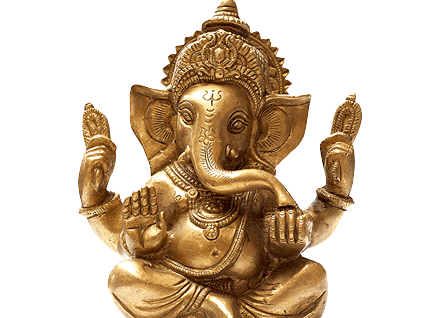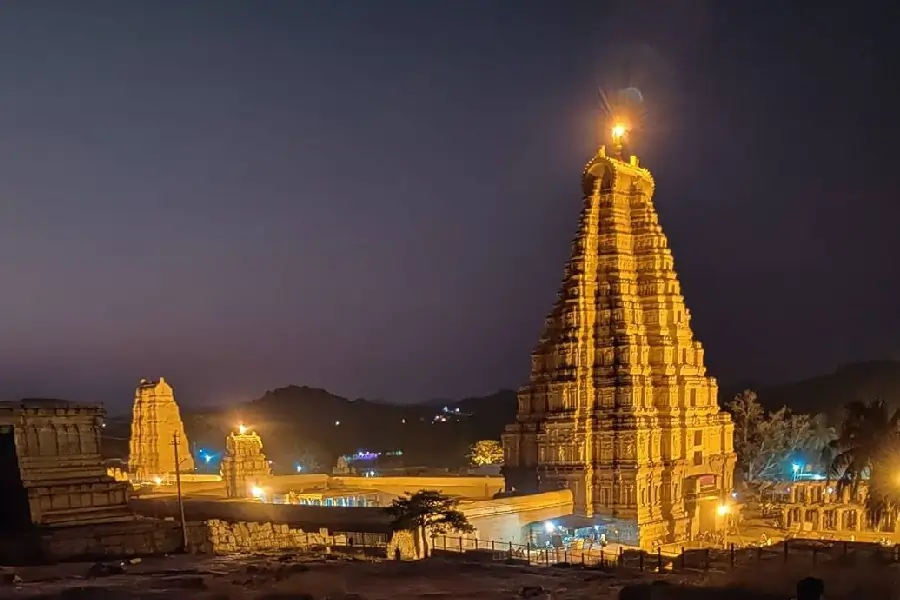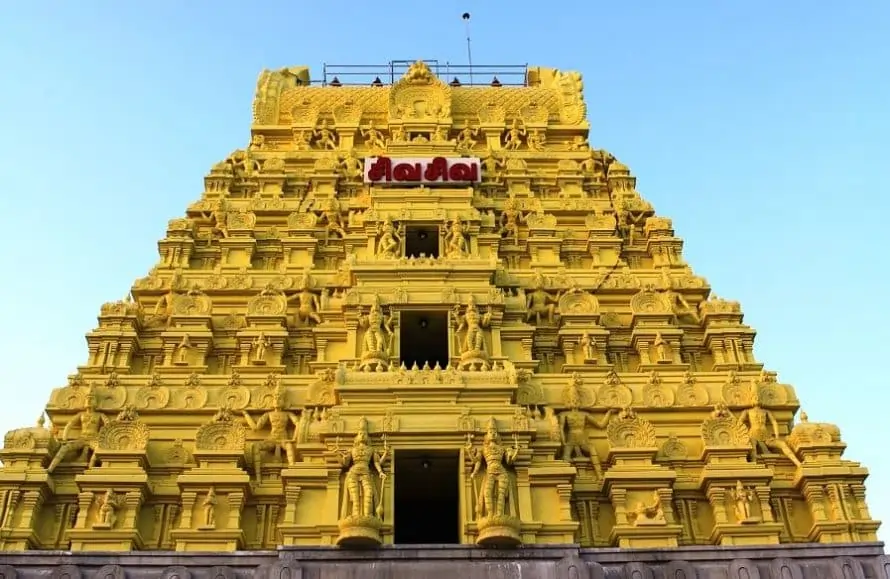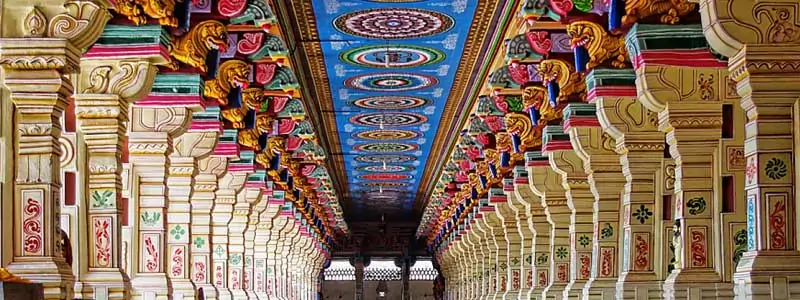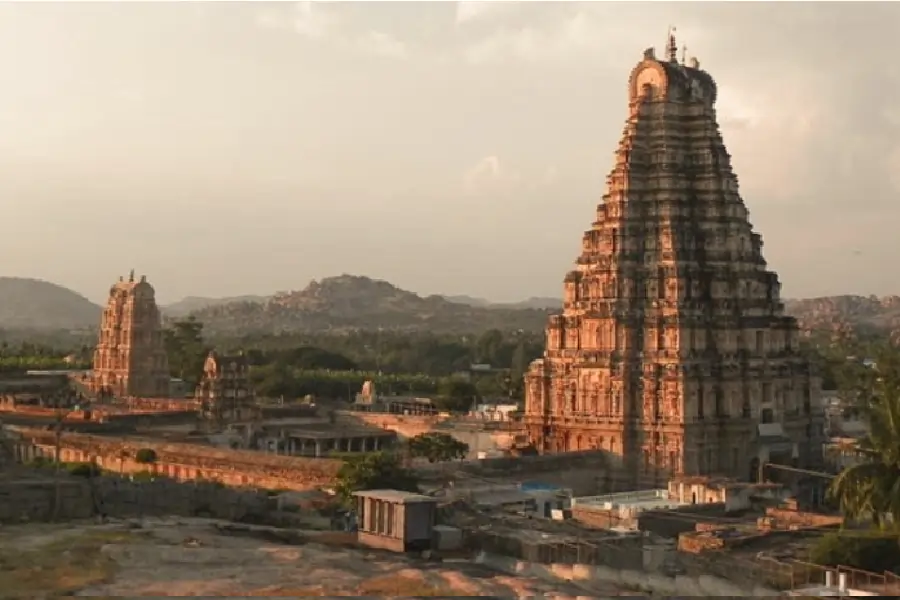
Vaishno Devi Temple

Vaishno Devi Temple is dedicated to Maan Durga, who is also known as Trikoota, Ambe, or Vaishnavi. The temple is located in Katra at the Trikoota Hill within the Indian UT of Jammu and Kashmir. Katra is about 61 km from Jammu city.
Significance Of the Temple:
The Vaishno Devi temple is one of the 108 ‘Shakti Peethas’ (seat of Shakti) located in India and is dedicated to Goddess Durga, who is worshipped here as Vaishno Devi. Vaishno Devi is believed to be the holiest of all Shakti Peethas. It is among the most visited pilgrimages of India, where millions of devotees come every year to get a darshan of Durga and get their wishes fulfilled. The number becomes very high during Navratri.
This is among the richest temples in India, which collects $16 million, in the form of donations and offerings.

Literary Mention of the Temple:
There is no record in the history of this temple, though Rigveda has a mention about Trikoota Hills, where this temple is located. It was only in the Pauranic period when Maan Shakti started getting worshipped. Though as per a geological study conducted, the age of the cave and the temple appear to be about a million years old.
The first mention of the Mother Goddess is found in Mahabharat. When the war was about to begin, Lord Krishna advised Arjun to worship Mother Goddess and seek her blessings for victory. At this point, Arjun refers to Mother Goddess by saying ‘Jambookatak Chityaishu Nityam Sannihitalaye’, which means ‘you who always dwell in the temple on the slope of the mountain in Jamboo’ (which probably may refer to Jammu of today).
After their victory, Pandavas are believed to have built the temples at Kol Kandoli and Bhawan in gratitude for the Mother Goddess. Just adjacent to Trikoota Mountain, overlooking the holy cave, there are 5 stone structures, which are supposed to represent the 5 Pandavas.
The oldest reference of some prominent figure visiting the temple is when the 10th guru of the Sikh religion, Guru Gobind Singh is said to have gone there via Purmandal.
History and Legend of the Holy Shrine:
The history and the legend of the holy shrine:
Like with most old Shrines, it is not possible to ascertain when exactly the pilgrimage to the Holy Shrine started.
There are several version and legends associated with the origin of Mata Vaishno Devi. As per the first legend, once the 3 main manifestations of Goddess (Mata Kalika, Mata Lakshmi and Mata Saraswati) decided to pool their collective ‘tej’ (spiritual strength), and produced a beautiful girl.
The 3 Devis asked the ‘girl’ to live on earth as a normal human being and spend her time upholding the dharma. The 3 Devis ordered her to attain higher levels of spiritual consciousness. She was told that once she attains it, she would merge into Vishnu and become one with him. They gave her all their blessings.
After some time, a very beautiful took birth in the house of Ratnakar and his wife, who used to live somewhere in South India, and were great devotees of Goddess. They named the daughter ‘Vaishnavi’. Since childhood, Vaishnavi displayed great intelligence and hunger for knowledge, which could not be satiated by any amount of teaching and learning. So, she started to meditate and conduct penance to bring her closer to her goal. She gave up all worldly comforts and left for the deep forest for meditation. While in meditation, she met Lord Rama, who was searching for his lost wife Sita (who had been kidnapped by the demon king of Lanka, Raavan). Vaishnavi recognized him as an incarnation of Lord Vishnu and requested him to merge her into himself so that she could become one with the supreme creator.
Realising that the time was not appropriate, Lord Rama told her that at the end of his exile, he would visit her again. And, if Vaishnavi is able to recognize him, he would agree to her wish. Lord Rama kept his words, and after killing Raavan when to visit her, but in the disguise of an old man. This time, Vaishnavi could not recognize him and felt disappointed. Lord Rama consoled her by saying that the appropriate time will come when they will become one. He said, “the appropriate time will come in Kaliyug when he would take the ‘Kalki’ avatar”. Lord Rama then directed her to meditate, at the base of Trikoota hills. He suggested enhancing her level of spirituality and helping mankind by removing their sufferings. As directed, Vaishnavi, left for Trikoota Hills, established an Ashram and began to meditate.
With time, her glory spread, and people started to visit her Ashram and seek her blessings. A great saint, Goraksh Nath, who had a vision of the dialogue between Lord Rama and Vaishnavi, became curious to find out whether or not Vaishnavi has been able to attain a high level of spirituality. He ordered his most able disciple ‘Bhairon Nath’ to find out the truth. When Bhairon Nath saw Vaishnavi in a ‘sadhvi’ form, he attracted by her beauty. He lost all his good sense and forgot why he had come here, and started pestering Vaishnavi to marry him.
In the meantime, an ardent follower of Goddess, Pandit Shridhar a Bhandara
(Community meal) in which the whole village was invited. He even invited Guru Goraksh Nath and all his followers, which included Bhairon Nath also. During the course of the Bhandara, it is believed that Bhairon Nath asked for meat and liquor, to which Vaishnavi replied that this is Bhandara, and only vegetarian food is served here. Bhairon Nath tried to grab Vaishnavi, but she escaped and decided to flee away into the mountains. But Bhairon Nath followed her.
The Goddess, while escaping stopped for few moments at some places, which are now holy spots. These places are today known as Banganga, Charan Paduka, and Ardh-kunwari (also called Hathi Matha). Ardh-Kunwari is the place, where Vaishnavi spent 9 months when Bhairon was chasing her.
Finally, Vaishnavi reached her cave. But Bhairon Nath followed her here also. Now, Goddess had no option. She took the form of Chamunda and beheaded him, just outside the mouth of the cave. His severed head fell at a distant hilltop. Bhairon realised his mistake and asked for forgiveness. The Mother forgave him and gave a boon that every devotee who comes to visit her would have to visit ‘Bhairon Dhaam’ after having the darshan of the Goddess. Only then he would get the fruits of this yatra.
At this point, Vaishnavi decided to give up on her human form. She assumed the face of a rock and immersed herself into meditation forever. The 5 feet 6 inches rock with 3 pindies is believed to be Vaishnavi in the form of rock. These 3 pindies in the holy cave constitute the garbh-gruha (sanctum), also called ‘Bhavan and is famous as the Shri Mata Vaishno Devi shrine. There is a small river called ‘Banganga’, which is a perennial river and flows round the year. Water is brought from this river which is used to wash the feet of the three idols.
Since then the goddess is said to have been waiting for Lord Vishnu to take his tenth incarnation, as ‘Kalki’ and then she would merge into him.
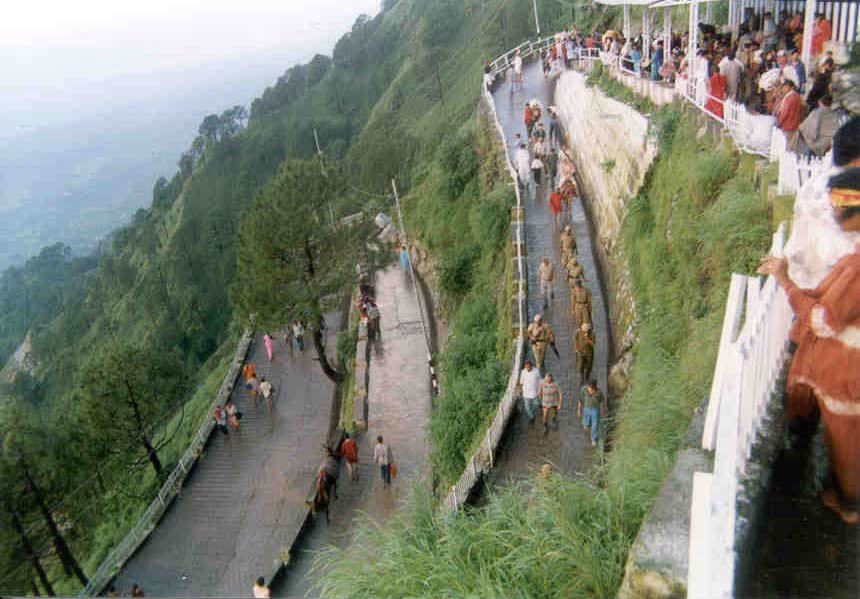
Discovery of the Shrine:
Unlike the ambiguity on the origin of Vaishno Devi, there is unanimity on the discovery of the shrine. Now, after that Bhandara, when Vaishnavi escaped to the forest, Pandit Shridhar felt deep sorrow and stopped taking food or even water and closed himself in a room, continuously praying to her to reappear.
It is believed that Mata Vaishnavi appeared in his dream and guided him to search for her at the Holy Cave situated amidst the folds of the Trikoota Mountain. Pandit Shridhar left to discover the Holy Cave in the mountains, and finally, with the support of Goddess, he was able to locate the cave. When he entered inside, he found a rock form with three heads on top of it.
At this moment Mata Vaishno appeared before him in all her glory and introduced him to the three heads, now known as the Holy Pindies. She blessed him with a right to worship her manifestation. As ordered by Goddess, Pandit Shridhar spent his remaining life at the holy caves in her service and spreading the glory of the Holy Shrine all over the world.
Major Festivals Celebrated:
Two festivals, which are celebrated in a grand manner at Vaishno Devi Temple Diwali and Navratri. While Diwali celebrates the victory of light over darkness. Navratri celebrates the victory of the Goddess over several demons.
During the 9 days of Navratri, there is a huge crowd here. Artists from all over the country come and perform at the Vaishno Devi darbar.
How to reach the Vaishno Devi Temple?
To visit the Holy Shrine of Mata Vaishno Devi, one has to reach Katra, a small town at a distance of about 45 km from Jammu. Katra is the base camp for the yatra. And from here, devotees have to track for about 13 km to reach the Bhawan. Though now, there is a helicopter service, which takes you from Katra to Sanjhi Chhath. This is the highest point of the hill, and after this, the remaining journey to Bhawan is only downhill, which is not that tiring.
- By Air: The near airport is Jammu, which is at a distance of 36 from Katra. Jammu is well connected to the rest of India by air. Outside the airport, you will get taxis which will take you to Katra.
- By Train: Now, there are trains available till Katra. Both Jammu (station name Jammu Tawi) and Katra are connected to other parts of the country. Apart from normal trains, some special trains also run during the peak season.
- By Road: Jammu is well connected through the road also to the rest of India. There are regular buses from all major North Indian cities are for Jammu as well as Katra. Nearby major cities are: Amritsar (122 km), Shri Nagar (151 km), and Jalandhar (170 km)
How to reach Bhawan from Katra?
- Once you reach Katra, you need to register yourself at the registration counter and obtain a ‘Yatra Parchi’ (Journey Slip). Without this, you will not be able to start the climb.
- Now, from Katra there is a climb of 13 km to the Bhawan. There is a hill track and at several places, there are stairs as well.
- Most devotees walk both ways, while some prefer to ride a pony. Palki service is available for sick and elder people.
- On the way, don’t forget to visit smaller holy places like Baanganga, Charan Paduka, Ardh-Kunwari, and Sanjhi Chhat.
- Ardh-Kunwari is at the middle of the journey and an important stop. Without visiting this shrine, the journey is incomplete.
- Sanjhi Chhat is the highest point and offers a beautiful panoramic view of the hill.
- If you are walking on the track, the entire route is covered with shops on both sides. You have lots of shops selling eatables, gifts, CDs of devotional songs etc.

Best Time to Visit Vaishno Devi Temple:
Though the temple remains open throughout the year, the hill and the temples are covered with snow. So, the best time is in the summers, when the weather is perfect. But, if you plan to visit the temple in winters don’t forget to bring heavy woollens, wind-cheaters, caps and gloves.
External Link:
Official Website:
https://www.maavaishnodevi.org/
https://en.wikipedia.org/wiki/Vaishno_Devi
https://en.wikipedia.org/wiki/Vaishno_Devi_Temple
FAQs:
Q. 1: What is the starting point for the Vaishno Devi yatra?
Ans: Katra
Q. 2: What is the name of the 10th incarnation (Avtaar) of Lord Vishnu?
Ans: Kalki
Q. 3: Who was Bhairon Nath?
Ans: Bhairon Nath was a tantric and a disciple of Guro Goraksh Nath, who wanted to marry Vaishnavi. Finally, he was killed at the hands of Maan Chamunda.
Q. 4: What is Bhairon Nath Temple?
Ans: When Maan Chamunda beheaded Bhairon Nath, his severed head fell at a distant hilltop. The place, where his head fell is the ‘Bhairon Nath Temple. On asking for forgiveness, Goddess forgave him and gave him a boon that all people will have to visit your temple also, after visiting the Bhavan.
Q. 5: Which river flows near Vaishno Devi Temple?
Ans: Banganga
[/vc_column_text][/vc_column][/vc_row][vc_row][vc_column][vc_column_text]
Get Direction On Google Map
[/vc_column_text][vc_raw_html]JTNDaWZyYW1lJTIwc3JjJTNEJTIyaHR0cHMlM0ElMkYlMkZ3d3cuZ29vZ2xlLmNvbSUyRm1hcHMlMkZlbWJlZCUzRnBiJTNEJTIxMW0xNCUyMTFtOCUyMTFtMyUyMTFkMTMzNzkuODkzODY3MjMzNjk0JTIxMmQ3NC45NDkwNDE2JTIxM2QzMy4wMzA4Mjk1JTIxM20yJTIxMWkxMDI0JTIxMmk3NjglMjE0ZjEzLjElMjEzbTMlMjExbTIlMjExczB4MCUyNTNBMHhhMDRhYjYxMWFmMDQ4MTkxJTIxMnNWYWlzaG5vJTI1MjBEZXZpJTIxNWUwJTIxM20yJTIxMXNlbiUyMTJzaW4lMjE0djE2MjUwNDc0MDMxMTAlMjE1bTIlMjExc2VuJTIxMnNpbiUyMiUyMHdpZHRoJTNEJTIyMTAwJTI1JTIyJTIwaGVpZ2h0JTNEJTIyNDUwJTIyJTIwc3R5bGUlM0QlMjJib3JkZXIlM0EwJTNCJTIyJTIwYWxsb3dmdWxsc2NyZWVuJTNEJTIyJTIyJTIwbG9hZGluZyUzRCUyMmxhenklMjIlM0UlM0MlMkZpZnJhbWUlM0U=[/vc_raw_html][/vc_column][/vc_row]
[vc_row][vc_column][vc_column_text]
In Hindu mythology, women have got a very special place. When we talk of knowledge, we worship Maan Saraswati, when we think of wealth; we worship Maan Lakshmi, and when we think of power, the name that comes to our mind is Maan Durga. There are several temples of Goddess Durga, and Vaishno Devi temple holds a very special place along all these.
Vaishno Devi Temple:
| Mythological Vehicle: | Lion |
| Deities worshipped: | Mahakali, Mahalakshmi, and Mahasaraswati |
| Starting Point: | Katra |
| Altitude: | 5,200 feet |
Vaishno Devi Temple is dedicated to Maan Durga, who is also known as Trikoota, Ambe, or Vaishnavi. The temple is located in Katra at the Trikoota Hill within the Indian UT of Jammu and Kashmir. Katra is about 61 km from Jammu city.
Significance Of the Temple:
The Vaishno Devi temple is one of the 108 ‘Shakti Peethas’ (seat of Shakti) located in India and is dedicated to Goddess Durga, who is worshipped here as Vaishno Devi. Vaishno Devi is believed to be the holiest of all Shakti Peethas. It is among the most visited pilgrimages of India, where millions of devotees come every year to get a darshan of Durga and get their wishes fulfilled. The number becomes very high during Navratri.
This is among the richest temples in India, which collects $16 million, in the form of donations and offerings.

Literary Mention of the Temple:
There is no record in the history of this temple, though Rigveda has a mention about Trikoota Hills, where this temple is located. It was only in the Pauranic period when Maan Shakti started getting worshipped. Though as per a geological study conducted, the age of the cave and the temple appear to be about a million years old.
The first mention of the Mother Goddess is found in Mahabharat. When the war was about to begin, Lord Krishna advised Arjun to worship Mother Goddess and seek her blessings for victory. At this point, Arjun refers to Mother Goddess by saying ‘Jambookatak Chityaishu Nityam Sannihitalaye’, which means ‘you who always dwell in the temple on the slope of the mountain in Jamboo’ (which probably may refer to Jammu of today).
After their victory, Pandavas are believed to have built the temples at Kol Kandoli and Bhawan in gratitude for the Mother Goddess. Just adjacent to Trikoota Mountain, overlooking the holy cave, there are 5 stone structures, which are supposed to represent the 5 Pandavas.
The oldest reference of some prominent figure visiting the temple is when the 10th guru of the Sikh religion, Guru Gobind Singh is said to have gone there via Purmandal.
History and Legend of the Holy Shrine:
The history and the legend of the holy shrine:
Like with most old Shrines, it is not possible to ascertain when exactly the pilgrimage to the Holy Shrine started.
There are several version and legends associated with the origin of Mata Vaishno Devi. As per the first legend, once the 3 main manifestations of Goddess (Mata Kalika, Mata Lakshmi and Mata Saraswati) decided to pool their collective ‘tej’ (spiritual strength), and produced a beautiful girl.
The 3 Devis asked the ‘girl’ to live on earth as a normal human being and spend her time upholding the dharma. The 3 Devis ordered her to attain higher levels of spiritual consciousness. She was told that once she attains it, she would merge into Vishnu and become one with him. They gave her all their blessings.
After some time, a very beautiful took birth in the house of Ratnakar and his wife, who used to live somewhere in South India, and were great devotees of Goddess. They named the daughter ‘Vaishnavi’. Since childhood, Vaishnavi displayed great intelligence and hunger for knowledge, which could not be satiated by any amount of teaching and learning. So, she started to meditate and conduct penance to bring her closer to her goal. She gave up all worldly comforts and left for the deep forest for meditation. While in meditation, she met Lord Rama, who was searching for his lost wife Sita (who had been kidnapped by the demon king of Lanka, Raavan). Vaishnavi recognized him as an incarnation of Lord Vishnu and requested him to merge her into himself so that she could become one with the supreme creator.
Realising that the time was not appropriate, Lord Rama told her that at the end of his exile, he would visit her again. And, if Vaishnavi is able to recognize him, he would agree to her wish. Lord Rama kept his words, and after killing Raavan when to visit her, but in the disguise of an old man. This time, Vaishnavi could not recognize him and felt disappointed. Lord Rama consoled her by saying that the appropriate time will come when they will become one. He said, “the appropriate time will come in Kaliyug when he would take the ‘Kalki’ avatar”. Lord Rama then directed her to meditate, at the base of Trikoota hills. He suggested enhancing her level of spirituality and helping mankind by removing their sufferings. As directed, Vaishnavi, left for Trikoota Hills, established an Ashram and began to meditate.
With time, her glory spread, and people started to visit her Ashram and seek her blessings. A great saint, Goraksh Nath, who had a vision of the dialogue between Lord Rama and Vaishnavi, became curious to find out whether or not Vaishnavi has been able to attain a high level of spirituality. He ordered his most able disciple ‘Bhairon Nath’ to find out the truth. When Bhairon Nath saw Vaishnavi in a ‘sadhvi’ form, he attracted by her beauty. He lost all his good sense and forgot why he had come here, and started pestering Vaishnavi to marry him.
In the meantime, an ardent follower of Goddess, Pandit Shridhar a Bhandara
(Community meal) in which the whole village was invited. He even invited Guru Goraksh Nath and all his followers, which included Bhairon Nath also. During the course of the Bhandara, it is believed that Bhairon Nath asked for meat and liquor, to which Vaishnavi replied that this is Bhandara, and only vegetarian food is served here. Bhairon Nath tried to grab Vaishnavi, but she escaped and decided to flee away into the mountains. But Bhairon Nath followed her.
The Goddess, while escaping stopped for few moments at some places, which are now holy spots. These places are today known as Banganga, Charan Paduka, and Ardh-kunwari (also called Hathi Matha). Ardh-Kunwari is the place, where Vaishnavi spent 9 months when Bhairon was chasing her.
Finally, Vaishnavi reached her cave. But Bhairon Nath followed her here also. Now, Goddess had no option. She took the form of Chamunda and beheaded him, just outside the mouth of the cave. His severed head fell at a distant hilltop. Bhairon realised his mistake and asked for forgiveness. The Mother forgave him and gave a boon that every devotee who comes to visit her would have to visit ‘Bhairon Dhaam’ after having the darshan of the Goddess. Only then he would get the fruits of this yatra.
At this point, Vaishnavi decided to give up on her human form. She assumed the face of a rock and immersed herself into meditation forever. The 5 feet 6 inches rock with 3 pindies is believed to be Vaishnavi in the form of rock. These 3 pindies in the holy cave constitute the garbh-gruha (sanctum), also called ‘Bhavan and is famous as the Shri Mata Vaishno Devi shrine. There is a small river called ‘Banganga’, which is a perennial river and flows round the year. Water is brought from this river which is used to wash the feet of the three idols.
Since then the goddess is said to have been waiting for Lord Vishnu to take his tenth incarnation, as ‘Kalki’ and then she would merge into him.

Discovery of the Shrine:
Unlike the ambiguity on the origin of Vaishno Devi, there is unanimity on the discovery of the shrine. Now, after that Bhandara, when Vaishnavi escaped to the forest, Pandit Shridhar felt deep sorrow and stopped taking food or even water and closed himself in a room, continuously praying to her to reappear.
It is believed that Mata Vaishnavi appeared in his dream and guided him to search for her at the Holy Cave situated amidst the folds of the Trikoota Mountain. Pandit Shridhar left to discover the Holy Cave in the mountains, and finally, with the support of Goddess, he was able to locate the cave. When he entered inside, he found a rock form with three heads on top of it.
At this moment Mata Vaishno appeared before him in all her glory and introduced him to the three heads, now known as the Holy Pindies. She blessed him with a right to worship her manifestation. As ordered by Goddess, Pandit Shridhar spent his remaining life at the holy caves in her service and spreading the glory of the Holy Shrine all over the world.
Major Festivals Celebrated:
Two festivals, which are celebrated in a grand manner at Vaishno Devi Temple Diwali and Navratri. While Diwali celebrates the victory of light over darkness. Navratri celebrates the victory of the Goddess over several demons.
During the 9 days of Navratri, there is a huge crowd here. Artists from all over the country come and perform at the Vaishno Devi darbar.
How to reach the Vaishno Devi Temple?
To visit the Holy Shrine of Mata Vaishno Devi, one has to reach Katra, a small town at a distance of about 45 km from Jammu. Katra is the base camp for the yatra. And from here, devotees have to track for about 13 km to reach the Bhawan. Though now, there is a helicopter service, which takes you from Katra to Sanjhi Chhath. This is the highest point of the hill, and after this, the remaining journey to Bhawan is only downhill, which is not that tiring.
- By Air: The near airport is Jammu, which is at a distance of 36 from Katra. Jammu is well connected to the rest of India by air. Outside the airport, you will get taxis which will take you to Katra.
- By Train: Now, there are trains available till Katra. Both Jammu (station name Jammu Tawi) and Katra are connected to other parts of the country. Apart from normal trains, some special trains also run during the peak season.
- By Road: Jammu is well connected through the road also to the rest of India. There are regular buses from all major North Indian cities are for Jammu as well as Katra. Nearby major cities are: Amritsar (122 km), Shri Nagar (151 km), and Jalandhar (170 km)
How to reach Bhawan from Katra?
- Once you reach Katra, you need to register yourself at the registration counter and obtain a ‘Yatra Parchi’ (Journey Slip). Without this, you will not be able to start the climb.
- Now, from Katra there is a climb of 13 km to the Bhawan. There is a hill track and at several places, there are stairs as well.
- Most devotees walk both ways, while some prefer to ride a pony. Palki service is available for sick and elder people.
- On the way, don’t forget to visit smaller holy places like Baanganga, Charan Paduka, Ardh-Kunwari, and Sanjhi Chhat.
- Ardh-Kunwari is at the middle of the journey and an important stop. Without visiting this shrine, the journey is incomplete.
- Sanjhi Chhat is the highest point and offers a beautiful panoramic view of the hill.
- If you are walking on the track, the entire route is covered with shops on both sides. You have lots of shops selling eatables, gifts, CDs of devotional songs etc.

Best Time to Visit Vaishno Devi Temple:
Though the temple remains open throughout the year, the hill and the temples are covered with snow. So, the best time is in the summers, when the weather is perfect. But, if you plan to visit the temple in winters don’t forget to bring heavy woollens, wind-cheaters, caps and gloves.
External Link:
Official Website:
https://www.maavaishnodevi.org/
https://en.wikipedia.org/wiki/Vaishno_Devi
https://en.wikipedia.org/wiki/Vaishno_Devi_Temple
FAQs:
Q. 1: What is the starting point for the Vaishno Devi yatra?
Ans: Katra
Q. 2: What is the name of the 10th incarnation (Avtaar) of Lord Vishnu?
Ans: Kalki
Q. 3: Who was Bhairon Nath?
Ans: Bhairon Nath was a tantric and a disciple of Guro Goraksh Nath, who wanted to marry Vaishnavi. Finally, he was killed at the hands of Maan Chamunda.
Q. 4: What is Bhairon Nath Temple?
Ans: When Maan Chamunda beheaded Bhairon Nath, his severed head fell at a distant hilltop. The place, where his head fell is the ‘Bhairon Nath Temple. On asking for forgiveness, Goddess forgave him and gave him a boon that all people will have to visit your temple also, after visiting the Bhavan.
Q. 5: Which river flows near Vaishno Devi Temple?
Ans: Banganga
[/vc_column_text][/vc_column][/vc_row][vc_row][vc_column][vc_column_text]
Get Direction On Google Map
[/vc_column_text][vc_raw_html]JTNDaWZyYW1lJTIwc3JjJTNEJTIyaHR0cHMlM0ElMkYlMkZ3d3cuZ29vZ2xlLmNvbSUyRm1hcHMlMkZlbWJlZCUzRnBiJTNEJTIxMW0xNCUyMTFtOCUyMTFtMyUyMTFkMTMzNzkuODkzODY3MjMzNjk0JTIxMmQ3NC45NDkwNDE2JTIxM2QzMy4wMzA4Mjk1JTIxM20yJTIxMWkxMDI0JTIxMmk3NjglMjE0ZjEzLjElMjEzbTMlMjExbTIlMjExczB4MCUyNTNBMHhhMDRhYjYxMWFmMDQ4MTkxJTIxMnNWYWlzaG5vJTI1MjBEZXZpJTIxNWUwJTIxM20yJTIxMXNlbiUyMTJzaW4lMjE0djE2MjUwNDc0MDMxMTAlMjE1bTIlMjExc2VuJTIxMnNpbiUyMiUyMHdpZHRoJTNEJTIyMTAwJTI1JTIyJTIwaGVpZ2h0JTNEJTIyNDUwJTIyJTIwc3R5bGUlM0QlMjJib3JkZXIlM0EwJTNCJTIyJTIwYWxsb3dmdWxsc2NyZWVuJTNEJTIyJTIyJTIwbG9hZGluZyUzRCUyMmxhenklMjIlM0UlM0MlMkZpZnJhbWUlM0U=[/vc_raw_html][/vc_column][/vc_row]

